|
Back
to Illustrated Sites of Greece
Lion
Gate
Grave Circles
King's
Megaron
Cistern
Clytemnestra's Tomb
Treasury of
Atreus
Lion Tomb
|
 |
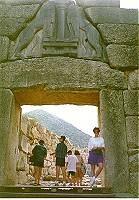
Dr. J's
Illustrated
Lion Gate at Mycenae
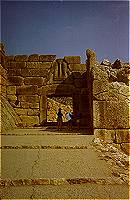 The Lion Gate
is the oldest monumental The Lion Gate
is the oldest monumental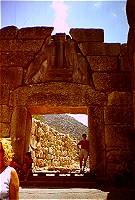 sculpture in Europe (not in
the world...just in Europe). We have always assumed that these are the same Mycenean lions
known from over 600 other art works (perhaps their steatite heads, now missing, faced
forward). Further investigation, though, has led some scholars to consider the possibility
that these are really griffins - the same griffins known from Minoan seal stones and
frescoes. Other Minoan influences on Mycenean art and architecture are undeniable, and
either animal would fulfill the purpose of the relief, for both lions and griffins were
symbols of authority, religious as well as political. sculpture in Europe (not in
the world...just in Europe). We have always assumed that these are the same Mycenean lions
known from over 600 other art works (perhaps their steatite heads, now missing, faced
forward). Further investigation, though, has led some scholars to consider the possibility
that these are really griffins - the same griffins known from Minoan seal stones and
frescoes. Other Minoan influences on Mycenean art and architecture are undeniable, and
either animal would fulfill the purpose of the relief, for both lions and griffins were
symbols of authority, religious as well as political. |
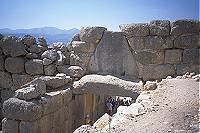 First
and foremost, the Lion relief serves a structural purpose: it fills (and therefore masks)
the triangular space created above the lintel in order to reduce the pressure of the
tremendous weight of the stones. This "relieving triangle" aspect of the frieze
can best be seen from the rear. First
and foremost, the Lion relief serves a structural purpose: it fills (and therefore masks)
the triangular space created above the lintel in order to reduce the pressure of the
tremendous weight of the stones. This "relieving triangle" aspect of the frieze
can best be seen from the rear. |
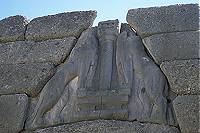 The
forepaws of the figures rest on a row of blocks carved above a double plinth, which may
represent altars. Their paws flank a single pillar, perhaps representing the propylon or
entry room, symbol of the power they guard. Perhaps this was the heraldic symbol of the
Royal House of Atreus. And note how the composition of the scene perfectly fits the space
it is designed to occupy. The
forepaws of the figures rest on a row of blocks carved above a double plinth, which may
represent altars. Their paws flank a single pillar, perhaps representing the propylon or
entry room, symbol of the power they guard. Perhaps this was the heraldic symbol of the
Royal House of Atreus. And note how the composition of the scene perfectly fits the space
it is designed to occupy. |
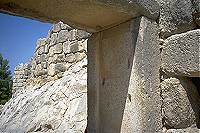 Clearly
visible in the lintel and threshold of the Lion Gate are the pivot holes for double doors
and holes that would have supported a wooden bar to lock the door. Clearly
visible in the lintel and threshold of the Lion Gate are the pivot holes for double doors
and holes that would have supported a wooden bar to lock the door. |
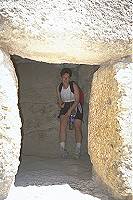 An open
compartment in the rock wall just inside the Lion Gate, not quite large enough to stand up
straight in. Suggestions for its use range from a guard post to a gate sanctuary (or, as
Paul Rehak suggests, a kennel for guard dogs!). Nobody knows for sure... An open
compartment in the rock wall just inside the Lion Gate, not quite large enough to stand up
straight in. Suggestions for its use range from a guard post to a gate sanctuary (or, as
Paul Rehak suggests, a kennel for guard dogs!). Nobody knows for sure... |
|







